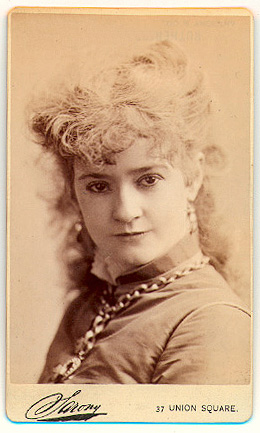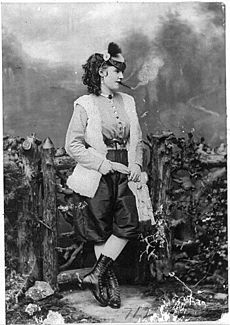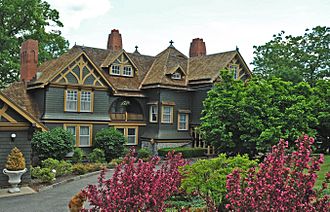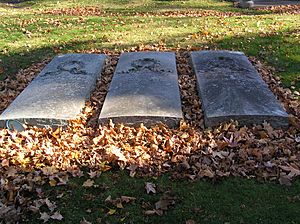Lotta Crabtree facts for kids
Quick facts for kids
Lotta Crabtree
|
|
|---|---|
 |
|
| Born |
Charlotte Mignon Crabtree
November 7, 1847 New York City, U.S.
|
| Died | September 25, 1924 (aged 76) Boston, Massachusetts, U.S.
|
| Resting place | Woodlawn Cemetery |
| Nationality | American |
| Occupation | Actress |
| Years active | 1853–1892 |
Charlotte Mignon "Lotta" Crabtree (born November 7, 1847 – died September 25, 1924) was a famous American actress and entertainer. People often just called her Lotta. She was also a comedian and helped many charities.
Lotta was born in New York City but grew up in California's gold mining areas. She became famous as a child performer, starting when she was just 6 years old! Lotta was one of the richest and most loved entertainers in America during the late 1800s. She was even called "The Nation's Darling". Her exciting life story was made into a movie called Golden Girl in 1951.
Contents
Early Life and First Performances
Charlotte Mignon Crabtree was born in New York City on November 7, 1847. Her father, John Crabtree, was a bookseller. He went to San Francisco in 1851 to find gold during the California Gold Rush.
Lotta and her mother, Mary Ann Crabtree, followed him two years later. They joined John in a busy town called Grass Valley. There, the Crabtrees ran a boarding house. Lotta soon caught the eye of a neighbor, the dancer Lola Montez. Lola encouraged Lotta's love for performing.
The Crabtrees moved again and opened another boarding house in Rabbit Creek. Soon after, Lotta performed for the first time at a tavern there. She started touring the California mining camps. She became known as a great dancer, singer, and banjo player.
In 1856, her family moved back to San Francisco. Lotta became a star at The Gaieties, a theater and saloon. By 1859, she was known as "Miss Lotta, the San Francisco Favorite". Lotta's mother was her manager. She collected all of Lotta's earnings in gold, carrying it in a big leather bag. When it got too heavy, she put it in a large trunk!
When silver was found in Nevada in 1859, Lotta became a regular star there. She first performed in Nevada in 1863. Lotta was full of fun and energy. She would make funny faces, twist her finger in her dimple, and put coins thrown on stage into her stockings. She was known for being a happy and playful performer.
Becoming a National Star
After becoming famous in California, Lotta left in 1863 to tour the East Coast. There, she started acting in plays like The Old Curiosity Shop and Uncle Tom's Cabin. Because she was small, she was perfect for playing child characters.
In the late 1860s, the "Lotta Polka" and "Lotta Gallup" dances were very popular in America. By age 20, she was a national star! By 1875, Lotta was touring the country with her own theater company. She was most successful in the 1870s and 1880s.
In the 1880s, she was the highest-paid actress in America. She earned as much as $5,000 per week! Her mother, Mary Ann, still managed Lotta's business. She booked plays, found locations, and organized groups of actors. When the money trunk became too heavy, she invested Lotta's earnings. She bought local real estate, race horses, and bonds.
Lotta also used some of her money to help charities and build fountains. Lotta's Fountain is the most famous of these. It still stands in San Francisco. People meet there every April 18 to remember the 1906 San Francisco earthquake.
Lotta traveled abroad with her mother and brothers. She learned French, visited museums, and started painting. After her trip, Lotta returned to San Francisco. She performed at the California Theatre. The city was so happy she was back and treated her like their own special star.
In 1885, Lotta's mother had a large summer house built in Mount Arlington, New Jersey. It was called Attol Tryst, which is "Lotta" spelled backward. The house was designed by a famous architect, Frank Furness. Lotta hosted parties there, rode horses, and continued her painting. The house is still there today and has been restored.
Retirement and Legacy
Lotta Crabtree had to retire because she fell onstage in 1889. After getting better, she tried to come back in 1891 but decided to retire for good. She was 45 years old and the richest actress in America. The theater world was changing, and she left at the top of her career. She made one last public appearance in 1915 for "Lotta Crabtree Day" at the Panama-Pacific Exposition in San Francisco.
Lotta never married. Her busy travel schedule and her mother's constant presence made a long-term relationship difficult. After retiring, Lotta traveled and painted. She also did a lot of charity work. Later in life, she moved to Massachusetts. She owned land there, which was bought for her brother and their horses.
Lotta spent her last 15 years at the Brewster Hotel in Boston, which she had bought in 1909. She died there on September 25, 1924, at age 76. The New York Times newspaper called her the "eternal child" in her obituary. Critics described her as playful, unpredictable, and cheerful.
She was buried at the Woodlawn Cemetery in Bronx, New York. Lotta left about $4 million in a special trust fund. This money was for charities that helped veterans, older actors, and animals. The trust still exists today, helping many causes.
Memorials
- Miss Lotta of Lake Hopatcong Cruises, a boat named after Lotta Crabtree.
- Crabtree Hall, a dormitory at the University of Massachusetts Amherst, is named for Lotta.
- Lotta's Fountain, at Geary & Market Streets in San Francisco.
- Lotta Fountain, at the Charles River Esplanade in Boston.
- Lotta Window, a stained glass window dedicated to her mother in Chicago.
- Attol Tryst, her former summer home in Lake Hopatcong, New Jersey (not open to the public).
Images for kids
-
Lotta's Fountain, San Francisco, California (built 1875; 1905 photo)
-
Lotta's Fountain, downtown San Francisco (2008 photo)
-
Lotta Fountain, Charles River Esplanade, near Berkeley Street, Boston (built 1939; 2009 photo)







